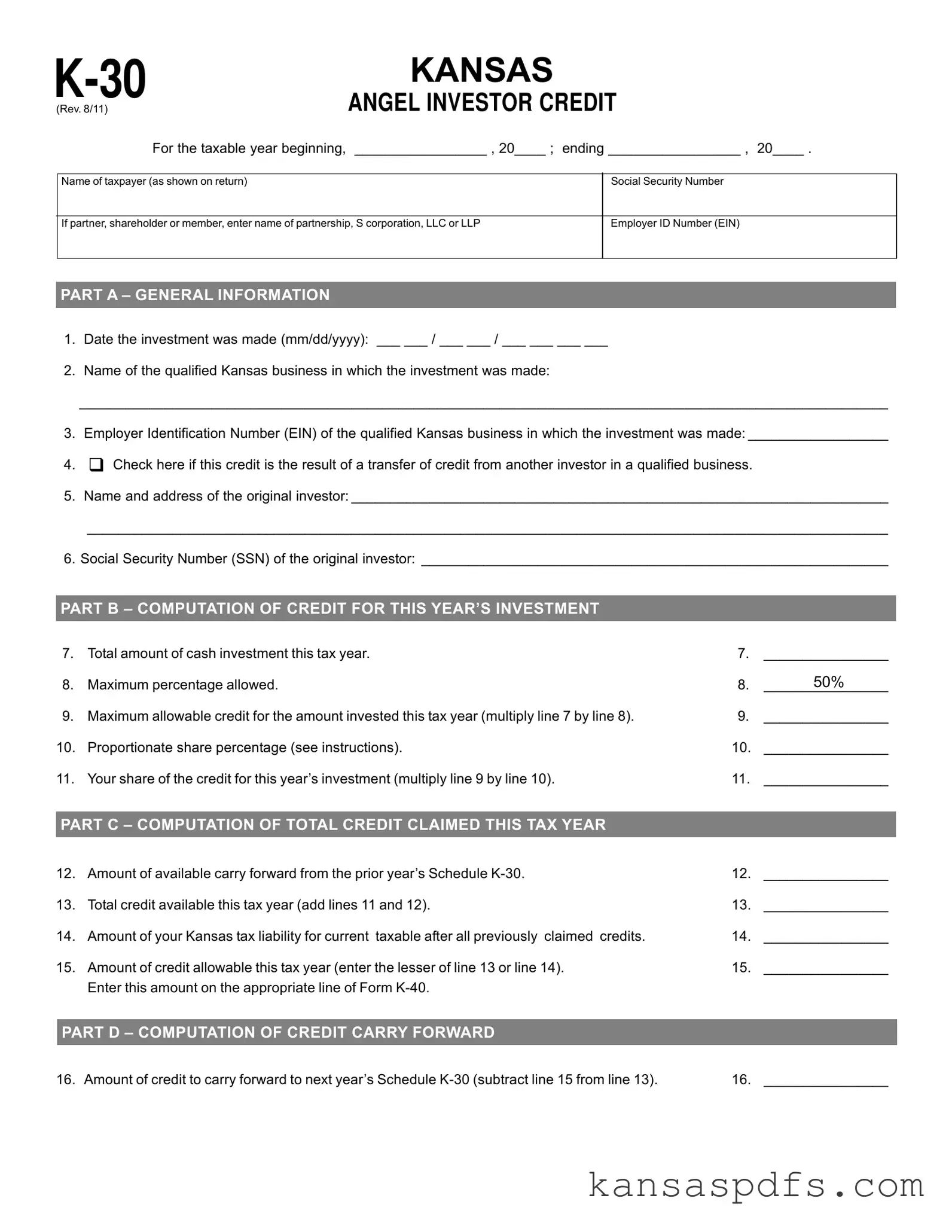|
|
GENERAL INSTRUCTIONS |
SPECIFIC LINE INSTRUCTIONS |
|
K.S.A. 74-8133 provides a tax credit against the income or |
|
|
PART A —GENERAL INFORMATION |
|
|
premium tax of any angel investor for a cash investment in the |
LINES 1 through 6 – Complete the information for the qualified |
|
qualified securities of a qualified Kansas business. |
|
Kansas business and original investor as requested. |
|
Before an angel investor may be entitled to receive tax credits, |
|
|
|
|
such investor must have made a cash investment in a qualified |
PART B —COMPUTATION OF CREDIT FOR THIS YEAR’S INVESTMENT |
|
|
security of a qualified Kansas business. The investment must be |
LINE 7 – Enter total amount of cash investment made this tax year. |
|
made in a business that has been approved by KTEC (Kansas |
|
LINE 8 – This percentage determines the maximum credit allowable |
|
Technology Enterprise Corporation) as a qualified business prior |
|
as a result of the investment made during this tax year. Do not |
|
to the date on which the cash investment is made. For information |
|
make an entry on this line. |
|
and assistance regarding the approval of a qualified Kansas |
|
LINE 9 – Multiply line 7 by line 8 and enter the result. This is the |
|
business, contact KTEC at (785) 296-5272. |
|
maximum credit allowable. |
|
The credit is 50% of such investors’ cash investment in any |
|
LINE 10 – Partners, shareholders or members: Enter the percentage |
|
qualified Kansas business, subject to the following limitations: |
|
that represents your proportionate share in the partnership, S |
|
|
|
|
• No tax credits will be allowed for more than $50,000 for a single |
corporation, LLC or LLP. All other taxpayers: Enter 100%. |
|
|
Kansasbusinessoratotalof$250,000intaxcreditsforasingle |
LINE 11 – Multiply line 9 by line 10 and enter result. This is your |
|
|
year per investor who is a natural person or owner of a |
share of the total credit for the amount invested this year. |
|
|
permitted entity investor. |
|
|
|
|
PART C —COMPUTATION OF TOTAL CREDIT CLAIMED THIS TAX YEAR |
|
|
• No tax credits shall be allowed for any cash investments in |
|
|
LINE 12 – Enter the carry forward amounts available from prior |
|
|
qualified securities for any year after the year 2016. |
|
• |
The total amount of tax credits shall not exceed $6,000,000 |
years’ K-30 schedules and enclose a copy of those schedules. |
|
2010 legislation (SB 430) allows taxpayers that had credits |
|
|
for tax year 2008 and each tax year thereafter, except that for |
|
|
earned pursuant to K.S.A. 74-8133 to carry forward to tax |
|
|
tax year 2011, the total amount of tax credits shall not exceed |
|
|
year 2011 any reduction that occurred in tax year 2009 |
|
|
$5,000,000. |
|
|
and/or 2010. Enter those amounts here on line 12. |
|
• |
No investor shall claim a credit for cash investments in Kansas |
|
LINE 13 – Add lines 11 & 12 and enter the result. |
|
|
Venture Capital, Inc. |
|
|
LINE 14 – Enter your total Kansas tax liability for the current tax |
|
• |
No Kansas venture capital company shall qualify for the tax |
|
year after all credits other than the credit allowed for |
|
|
credit for an investment in a fund created by articles 81, 82, |
|
|
investments made during this tax year. |
|
|
83 or 84 of chapter 74 of the Kansas Statutes Annotated. |
|
|
LINE 15 – Enter the lesser of line 13 or line 14. Enter this amount |
|
If the amount by which that portion of the credit allowed by this |
|
on the appropriate line of Form K-40. |
|
section exceeds the investors’ liability in any one taxable year, the |
|
|
|
|
PART D —COMPUTATION OF CARRY FORWARD CREDIT |
|
|
remaining portion of the credit may be carried forward until the total |
|
|
|
|
|
amount of the credit is used. If the investor is a permitted entity |
LINE 16 – Subtract line 15 from line 13 and enter result. This |
|
investor, the credit provided by this section shall be claimed by the |
|
amount cannot be less than zero. Enter this amount on next |
|
owners of the permitted entity investor in proportion to their |
|
year’s Schedule K-30. |
|
|
|
|
ownership share of the permitted entity investor. |
|
|
|
Subject to certain restrictions this credit may be transferred to |
IMPORTANT: Do not send any enclosures with this |
|
schedule. A copy of the approved KTEC certification |
|
another taxpayer. Contact KTEC at (785) 296-5272 for more |
|
form must be kept with your records. If this is a credit |
|
information. |
|
that has been transferred, documentation of the approved transfer |
|
|
|
|
“Angel investor’’and ‘‘investor’’meanYXWVUTSRan accredited investor |
|
|
|
as provided by KDOR (Kansas Department of Revenue) must be |
|
who is a natural person or an owner of a permitted entity investor, |
retained with your records. KDOR reserves the right to request |
|
who is of high net worth, as defined in 17 C.F.R. 230.501(a) as in |
additional information as necessary. |
|
effect on the effective date of this act, and who seeks high returns |
|
|
|
through private investments in start-up companies and may seek |
TAXPAYERASSISTANCE |
|
active involvement in business, such as consulting and mentoring |
For assistance in completing this schedule contact the Kansas |
|
the entrepreneur. |
|
Department of Revenue: |
|
“Cash investment” means money or money equivalent in |
|
Tax Operations |
|
consideration for qualified securities. |
|
Docking State Office Building, 1st fl. |
|
“Permittedentityinvestor”means any: a) general partnership, |
|
915 SW Harrison St. |
|
limited partnership, corporation that has in effect a valid election |
|
Topeka, KS 66625-2007 |
|
to be taxed as an S corporation under the United States Internal |
|
Phone: (785) 368-8222 |
|
Revenue Code, or a limited liability company that has elected to |
|
Fax: (785) 291-3614 |
|
be taxed as a partnership under the United States Internal Revenue |
|
|
|
|
Code; and, b) that was established and is operated for the sole |
Additional copies of this credit schedule and other tax forms |
|
purpose of making investments in other entities. |
are available from our web site at: ksrevenue.org |


